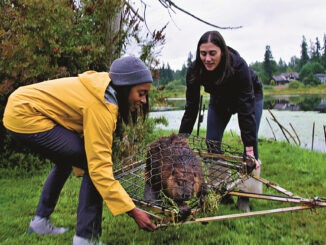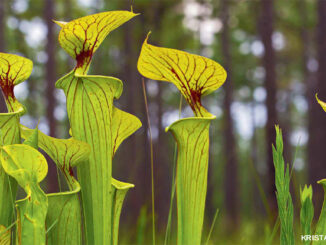
Helping Nature Near You
By Ranger Rick Staff; Art by Jack DesrocherNo matter where you live, you can get to know the wild creatures in your neighborhood—and then lend them a hand! Here are peeks at three different neighborhoods, along with some ideas for getting started wherever you live.
IN THE CITY
SHE’S HELPING!
 When Trinity Favazza, 14, was very young, she would explore the woods near her Detroit-area home with her family. One of her earliest memories is of listening to wood frogs singing in the spring. That’s when her love of frogs and other amphibians began.
When Trinity Favazza, 14, was very young, she would explore the woods near her Detroit-area home with her family. One of her earliest memories is of listening to wood frogs singing in the spring. That’s when her love of frogs and other amphibians began.
As Trinity got older, she learned as much as she could about amphibians, including that they’re one of the most threatened groups of animals in the world. Since then, Trinity has worked to teach people about the need to save amphibians and wetlands.
One of her projects to raise awareness is called “Amphibians Rock.” It encourages kids to paint amphibians on rocks, then hide them around their neighborhood for other kids to find. As one of the youngest members of the citizen science group FrogWatch USA, Trinity gathers information about frog calls and frog breeding, which she shares with local and national scientists.
Trinity continues to teach people about the importance of amphibians through social media and on her website, actionforamphibians.com. “I want to inspire young people like me to help save our beautiful world and all the creatures in it,” she says, “especially amphibians.”
WHAT CAN YOU DO?
MEET YOUR WILD NEIGHBORS
How many of your wild neighbors do you know? What birds have you seen? Do you have ground squirrels or tree squirrels? Are there lizards where you live? It’s fun to find out!
Find a special spot to call your own—a nearby park or your backyard, a stream or vacant lot. Now go explore! Here are some places to look: on plants; on tree trunks, branches and leaves; under
loose bark; under logs, rocks, and fallen leaves; and under or on water.
BE THE NEIGHBORHOOD EXPERT
Sketch or write about your wild neighbors in a nature journal—and tell your friends what you’ve found. What plants are growing? What animals did you see? You can even make a website about your neighborhood’s nature. Have a parent help you look online to learn how.
IT’S EASY BEING GREEN
Another great way to get to know nature is by spending a “green hour” outdoors. Check out thegreenhour.org for some great activities.
IN THE SUBURBS
SHE’S HELPING!
 Madhvi Chittoor, 9, was just 5 years old when she learned how harmful plastic trash is to wildlife. By age 7, she’d written and published a book about plastic pollution. She had also founded Madhvi 4 EcoEthics, which works to reduce pollution from Styrofoam and other plastics.
Madhvi Chittoor, 9, was just 5 years old when she learned how harmful plastic trash is to wildlife. By age 7, she’d written and published a book about plastic pollution. She had also founded Madhvi 4 EcoEthics, which works to reduce pollution from Styrofoam and other plastics.
Madhvi knew that Styrofoam is one of the worst kinds of plastic. So she worked for months to convince her Denver-area school district to switch from Styrofoam lunch trays to ones that are not harmful to the environment. This kept 7.6 million Styrofoam trays from going to the landfill each year!
Next, Madhvi convinced lawmakers to propose a statewide ban on Styrofoam take-out containers and single-use plastics in restaurants and grocery stores. And now she’s working for a global ban on plastics and harmful chemicals with a petition at madhvi4ee.com. No wonder Madhvi, who has a black belt in Taekwondo, likes to call herself the “No Styrofoam Ninja”!
WHAT CAN YOU DO?
MAKE YOUR SCHOOL AN ECO-SCHOOL
More than 5,500 schools around the country are making changes that help the environment. For example, they are recycling or finding ways to save energy. To learn how your school can become an Eco-School, have your teacher or parent go to nwf.org/Eco-Schools-USA.
WELCOME WILDLIFE
Want to attract wildlife to your backyard or schoolyard? It’s easy! To get animals to drop by or move in, here’s what you need to provide:
- Food. Anything from a simple bird feeder to a garden full of native plants with leaves, flowers, berries, and nuts and other seeds that animals like to eat.
- Water. A birdbath or shallow dish for birds, or a small pond for frogs and other water creatures.
- Shelter. Brush piles, stone walls, shrubs, and trees all make good hideaways.
- Places to Raise Young. Bird houses; bat houses; and certain trees, shrubs, and leafy plants (for insects) are great spots.
MAKE IT OFFICIAL
You can certify your backyard or schoolyard wildlife habitat with the National Wildlife Federation, the group that publishes Ranger Rick. To find out how, have an adult go to nwf.org/certify online.
ENDANGERED SPECIES
Want to help save endangered species? Here’s how.
- Find out which live near you. Go with a parent to fws.gov/endangered and enter your state.
- Do some research. Go to the library or search online to look up information about these species.
- Find groups of people who are helping your species. Check with your library or nature center and ask these questions:
• Is there a local environmental group you could join?
• Are there local animals or plants that need your help? - Spread the word. Make a poster. Write a report. Tell your class, friends, and neighbors. Give the endangered animals and plants in your area the attention they deserve!
IN THE COUNTRY
HE’S HELPING!
 Topher Jones, 13, first learned about endangered salmon at his school in Boise, Idaho. Salmon hatch in rivers, and then they spend time in the ocean until it’s time to return and lay eggs. But Topher learned that, years earlier, sockeye salmon were so endangered that, at one lake in Idaho, only a single salmon had returned.
Topher Jones, 13, first learned about endangered salmon at his school in Boise, Idaho. Salmon hatch in rivers, and then they spend time in the ocean until it’s time to return and lay eggs. But Topher learned that, years earlier, sockeye salmon were so endangered that, at one lake in Idaho, only a single salmon had returned.
People named this lone salmon “Lonesome Larry.” Topher was inspired by Larry’s story. He came up with the idea of “socks to save the sockeye!” Then he worked with an artist on a sockeye salmon design. Now he sells sockeye socks and other items at Idaho Steelheads ice hockey games and local coffee shops, as well as on his website, lonesomelarryproject.com. So far, Topher has raised more than $15,000 to protect the salmon! His ultimate goal is to raise $100,000.
“I’ve learned that the world has so many problems, but we can come up with solutions,” Topher says. “Everyone can help make a difference.”
WHAT CAN YOU DO?
BECOME A CITIZEN SCIENTIST
You can volunteer to help scientists who help wildlife. The information you collect can show scientists how animals are being affected by habitat loss and other problems. Here are two for you and your family to consider: FrogWatch USA (aza.org/frogwatch) and Audubon’s Christmas Bird Count (audubon.org/conservation/join-christmas-birdcount).
CLEAN IT UP
Litter is everywhere, but you can help get rid of it! You and your family can take part in National CleanUp Day in September. Have a parent help you look online at nationalcleanupday.org.
BE A BUTTERFLY HERO
Because of habitat loss, monarch butterflies are in trouble across the country. You can help them by planting milkweed that monarchs need to survive. Visit nwf.org/Butterfly-Heroes/About with a parent and take the Butterfly Heroes pledge to help save monarchs!
GO FOR IT!
Trinity is a winner of an Action for Nature Eco-Hero Award. Madhvi and Topher are winners of the Gloria Barron Prize for Young Heroes. If you’ve done a project for wildlife or the environment, you can try for these awards, too. Go to actionfornature.org or barronprize.org for information on how to apply.




















